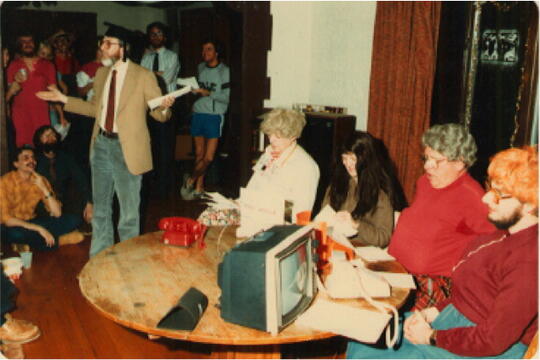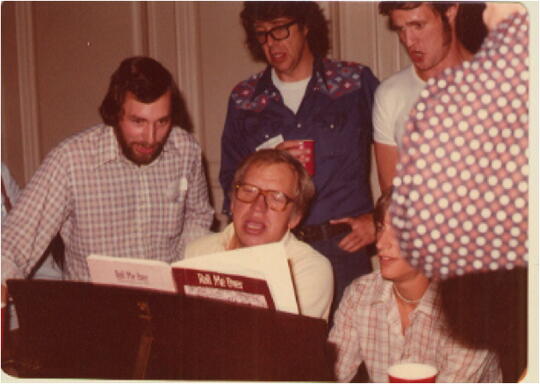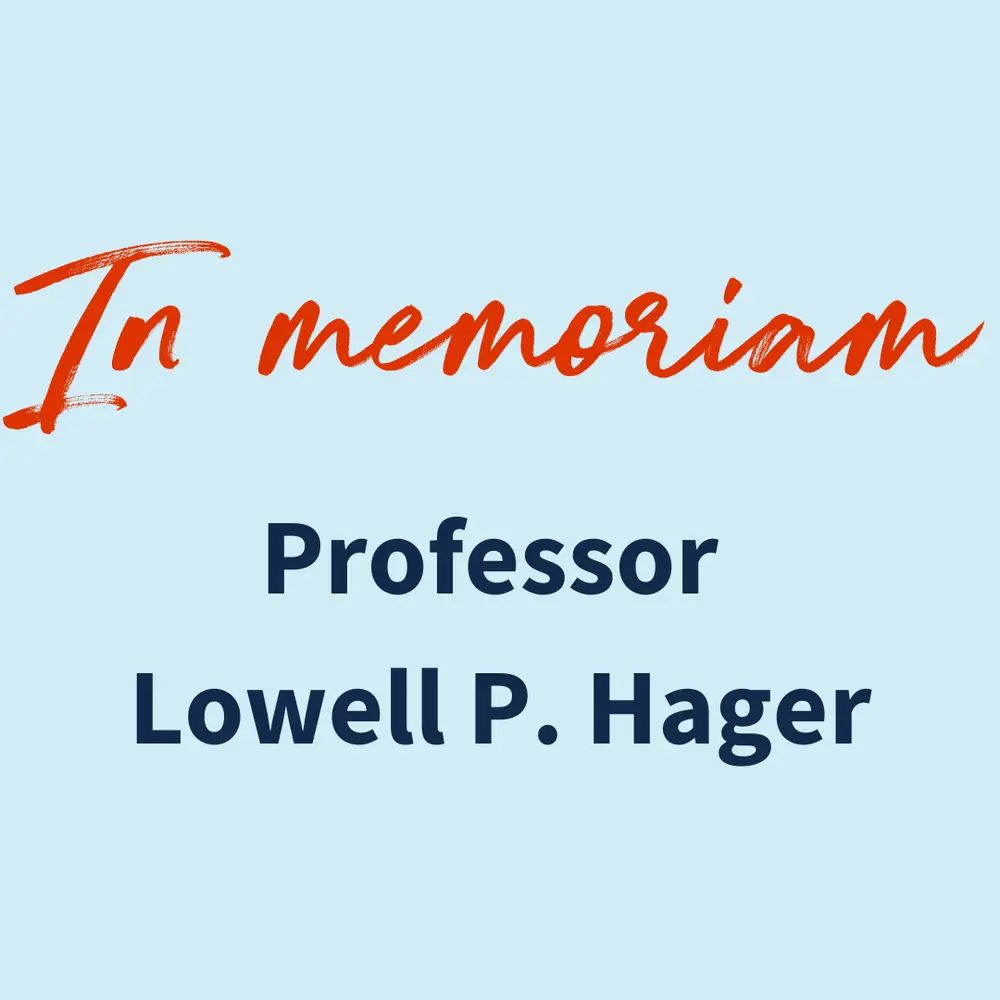
Professor Lowell P. Hager passed away peacefully on April 15, 2014 at the age of 87. Lowell was an internationally recognized enzymologist and protein chemist best known for his fundamental studies on halogenating enzymes and heme peroxidases. He joined the faculty at the University of Illinois in 1960 and, in 1967, became Head of Biochemistry, one of six large divisions in the Department of Chemistry and Chemical Engineering. One of his first actions as head was to lead the charge to convert the Chemistry and Chemical Engineering Department into a School of Chemistry, with each of the six Divisions becoming a Department, a change that took place in 1969. Lowell then became Head of the Department of Biochemistry in1969 and remained in that position for 20 years.
Lowell had the remarkable ability to maintain a top-notch research program while running and building the department in an efficient but very personal, cheerful and energetic manner. He cared deeply about the department and earned the trust and respect of the faculty by his openness and fairness. During his tenure at the helm of the department, he developed a strong sense of collegiality and community within the faculty and staff. He and his wife, Fran, opened their home to departmental parties and dinners involving visitors, students, postdocs and faculty. Besides his renown as a scientist, Lowell was also famous for his martinis (just a whiff of vermouth), his chili parties in their back yard each fall to welcome new graduate students, his establishment of retreats for the faculty and students at Allerton Park each fall where the students presented the talks and where, during the evenings, Lowell played the piano and led the gathering singers in his slightly bawdy sing-a-longs. Christmas parties at the Alpha Chi Sigma house featured skits by faculty and staff, often in outrageous outfits, presenting good-natured spoofs of our quirks and foibles. A life-long golfer himself, Lowell revived an earlier tradition of “The Biochemistry Open” each spring with all department members invited to display their talents, or lack thereof; and a scoring system which often allowed the duffers among us to win trophies. Lowell created an environment where creativity was fostered, scientific standards were high and doing science was fun. He left his mark on the department that remains to this day.
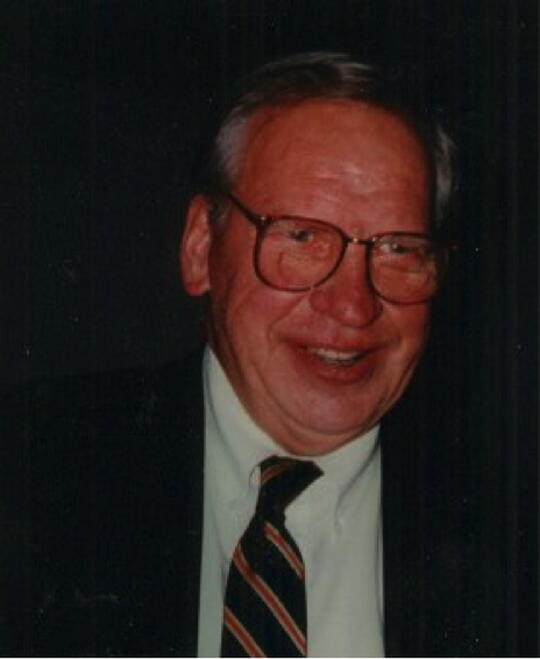
Born in 1926, Lowell was raised in the small town of Hepler in southeastern Kansas. He earned his bachelor’s degree in 1947 at Valparaiso University in Indiana, a master’s degree in 1950 from the University of Kansas, and his doctorate in 1953 in the laboratory of I.C. “Gunny” Gunsalus at the University of Illinois at Urbana-Champaign, after which he did postdoctoral studies with Fritz Lipmann at Harvard Medical School. He first joined the faculty in chemistry at Harvard in 1955 but returned to the University of Illinois as a faculty member, where he remained for the rest of his highly productive career. A more colorful account of these early days of Lowell’s career can be found in his memoir, “A Lifetime of Playing with Enzymes” in the Journal of Biological Chemistry, published in 2010 (http://www.jbc.org/lookup/doi/10.1074/jbc.X110.121905).
Lowell’s doctoral work in Gunny’s laboratory demonstrated the role of lipoic acid in the enzymes pyruvate dehydrogenase and α-ketoglutarate dehydrogenase. He discovered that each of these enzymes had lipoic acid dehydrogenase activity as well as lipoic transacetylase activity. In Fritz Lipmann’s laboratory at Harvard Medical School, Lowell continued work on pyruvate oxidation but in Lactobacillus delbrueckii, characterizing the enzyme that forms acetyl phosphate directly without the aid of lipoic acid. During his time as an Assistant Professor at Harvard from 1955 to 1960, Lowell continued work on the biochemistry of pyruvate oxidation. He discovered the enzyme pyruvate oxidase in a mutant of E. coli, and showed that this enzyme is what is now called a “monotopic” membrane protein which exists in a water-soluble form and, upon reduction of its flavin cofactor, binds to the membrane and uses ubiquinone as an electron acceptor. He brought this project with him when he moved to the University of Illinois.
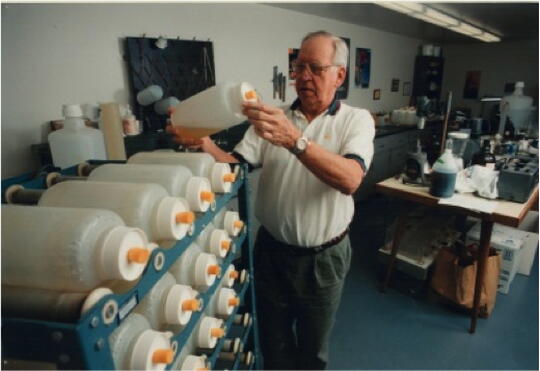
While preparing lectures for his course in comparative biochemistry, Lowell was introduced to biological halogenation reactions and decided to launch a new project to define the enzymology, which was totally unknown. As Lowell liked to tell the story, the first paper in this area was published by Pliny the Elder in the first century AD, describing the making of Tyrian Purple (6,6’-dibromoindigo), a valuable dye made from secretions of the murex shellfish and used to color Roman robes purple. Two thousand years later, the second paper on this topic was published in JACS by Paul Shaw and Lowell in 1959 on the chloroperoxidase (CPO) from the soil fungus Caldariomyces fumago. The study of CPO and related enzymes remained at the center of Lowell’s scientific career. In 1972 the NSF funded a grant to Lowell and Ken Reinhart for isolation and characterization of new halogenated compounds from marine organisms. This was accomplished by collecting samples on expeditions off the coast of California using the Alpha Helix research ship, which was equipped for onboard analysis of lipid extracts. This led to the discovery of many brominated natural products along with a bromoperoxidase enzyme isolated from green algae.
Lowell’s studies on chloroperoxidase took Lowell in several fruitful directions. Among his best known achievements was the characterization in 1981 of the “green intermediate” in the reaction, which proved to be common to a number of peroxidase enzymes and which is now known as Compound I. The versatility of CPO in catalyzing a number of useful enantioselective reactions was explored with the idea of using CPO in the efficient and inexpensive manufacture of chiral compounds. For this purpose Lowell founded the company Chirazyme Labs to produce large quantities of marketable CPO, a company which persists to this day under the direction of Lowell’s son, Paul.
While at the University of Illinois, Lowell mentored approximately 50 doctoral students and published over 400 papers. He was elected to the National Academy of Sciences in 1995, and was the inaugural recipient of the William Rutter Chair in Biochemistry in 1996.
Lowell enjoyed pointing out that many of the scientists in whose laboratories he spent time went on soon afterwards to be awarded the Nobel Prize. These included Fritz Lipmann and Konrad Bloch in his early years, and Fedor Lynen, Hans Krebs and Renato Dulbecco, with whom Lowell spent sabbaticals.
Indeed, Lowell did have a magic touch. We will all miss him.
